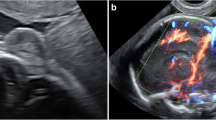Abstract
Introduction
Iniencephaly, a neural tube defect involving occiput and inion and combined with rachischisis of the cervical, thoracic spine, and retroflexion position of the head is a very rare congenital abnormality of the fetus–newborn with a 0.1–10 of 10,000 prevalence. This abnormality’s prognosis is thought to be dismal. This abnormality can be associated with other abnormalities such as anencephaly, encephalocele, hydrocephalus, cyclopia, absence of the mandible, cleft lip and palate, cardiovascular disorders, diaphragmatic hernia, renal abnormalities, overgrowth of the arms compared to the legs, and club food and gastrointestinal atresia.
Discussion
Most of the patients are dead born, and the others die in a few hours. There are only six previously documented long-term survivors. In our case, our patient with iniencephalic signs and findings is still living. She is 2 years old now. We think that this patient presents a mild form of iniencephaly.



Similar content being viewed by others

References
Aleksic S, Budzilovich G, Greco MA et al (1983) Iniencephaly: a neuropathologic study. Clin Neuropathol 2:55–61
Bhambhani V, George S (2004) Association of clomiphene with iniencephaly. Indian Pediatr 41(5):517
Erdincler P, Kaynar MY, Canbaz B et al (1998) Iniencephaly: neuroradiological and surgical features. J Neurosurg 89:317–320
Gartman JJ, Melin TE, Lawrence WT et al (1991) Deformity correction and long-term survival in an infant with iniencephaly. J Neurosurg 75:126–130
Katz VL, Aylsworth AS, Albright SG (1989) Iniencephaly is not uniformly fatal. Prenat Diagn 9:595–599
Loo CKC, Freeman B, Stanford D (2001) CNS findings in iniencephaly: case report and literature review. Pathology 33:112–115
Morocz I, Szeifert GT, Molnar P et al (1986) Prenatal diagnosis and pathoanatomy of iniencephaly. Clin Genet 30:81–86
Ramakrishnan S, Sharma D, Ramakrishnan V et al (1991) Iniencephaly with cyclopis (a case report). J Postgrad Med 37:51–52, 52A
Romero R, Pilu G, Jeanty P, Ghidini A, Hobbins JC (1988) Prenatal diagnosis of congenital anomalies. Appleton and Lange, Norwalk, CN
Shoham Z, Caspi B, Chemke J et al (1988) Iniencephaly: prenatal ultrasonographic diagnosis—a case report. J Perinat Med 16:139–143
Williamson RA, Weiner CP, Yuh WT et al (1989) Magnetic resonance imaging of anomalous fetuses. Obstet Gynecol 73(6):952–956
Author information
Authors and Affiliations
Corresponding author
Rights and permissions
About this article
Cite this article
Aytar, M.H., Doğulu, F., Cemil, B. et al. Iniencephaly and long-term survival: a rare case report. Childs Nerv Syst 23, 719–721 (2007). https://doi.org/10.1007/s00381-007-0309-6
Received:
Published:
Issue Date:
DOI: https://doi.org/10.1007/s00381-007-0309-6



